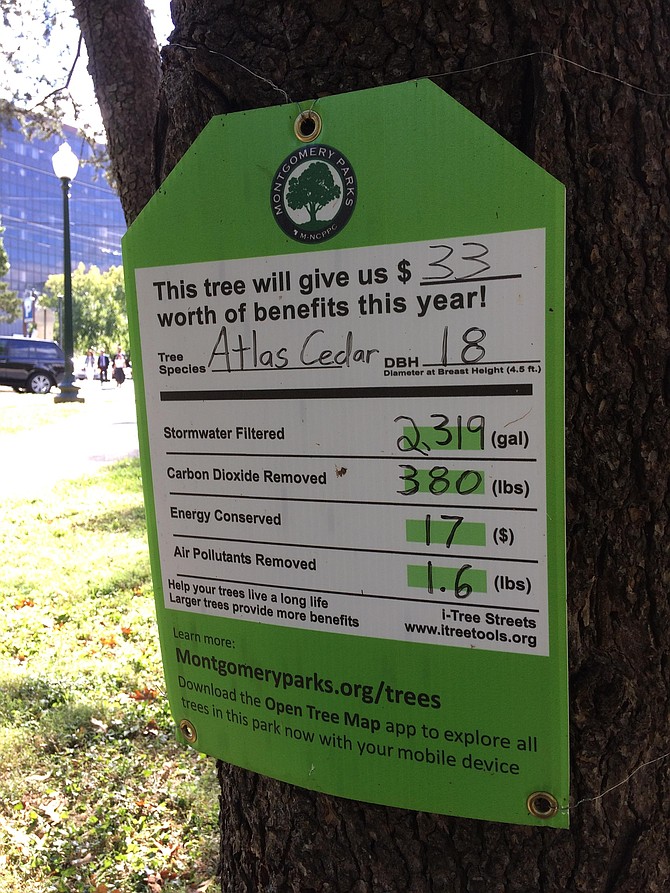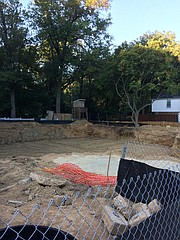Montgomery County publicizes the benefits of trees with tags noting how many gallons of water they filtered and how many cubic feet of air cleaned. Montgomery County has programs that address a wide range of opportunities to expand their forests – both public and private. Photo by Eden Brown.
Arlington’s Civic Federation, also known as CIVFED or the ACCF, wants the County Board to fund a new tree canopy study. The County says it already did that, back in 2017, with the Davey Resource Group. Why is there an issue?
The CivFed comprises about 100 civic associations, including local groups like the Tree Stewards, the NAACP, Arlington Branch 7047, and the Arlington Education Association. It is a cross section of the county. Its members are interested in what’s important to the actual citizen and it has gotten more active in the past year or so, according to Mary Glass, of the Arlington Tree Action Group (ATAG), examining the bigger problems in Arlington. Maintaining tree canopy is one of them.
Glass, who is chairman of the Environmental Affairs Committee, said the group had a series of three virtual meetings, brought in subject-matter experts, and made a number of recommendations for improving the environment in Arlington. One recommendation was to update the tree canopy survey. Environmentalists did not like the way the former study in 2017 by the Davey Resource Group was done. ATAG registered its concern in 2018. University of Vermont analysts called it only 94 percent accurate.
Urban tree canopy — measuring tree canopy percentage from overhead imagery — is a specific technique to measure tree canopy. Tree canopy is important because large trees improve water quality, conserve energy, lower city temperatures, reduce air pollution, prevent flooding, enhance property values, provide wildlife habitat, facilitate social and educational opportunities, and are good for the aesthetics of the neighborhood. Tree canopy studies are usually performed using high-resolution satellite photography, and involve significant analysis by Geographic Information Systems technicians.
The problem, according to the ATAG and some urban forestry experts, is inconsistent quality of the studies. The tree canopy study in 2011 indicated a drop in tree canopy to 40 percent down from 43 percent in 2008. The 2017 study, using 2016 data, indicates a tree canopy of 41 percent. A small gain. A detailed briefing by Karen Firehock, who is head of the Green Infrastructure Center in RIchmond, Va., disputed the conclusion that the tree canopy was holding steady, contending it had declined. Firehock gave a briefing to the CivFed in March 2021, laying out the logic for a new tree canopy study. A resolution was drafted at the March meeting and was approved and sent to the county board in March, but has not been acted upon. “The thing that did it for me,” said Glass, who believes the political will for a new tree study is lacking on the county board, “is that Arlington recently did a deer survey which cost $48,000. Tree canopy studies are relatively inexpensive, costing about $20,000.“
Takis Karantonis, a relatively new member of the Arlington County Board, and an urban planner, said “We know some advocates have suggested more scientific data on tree canopy in Arlington. Of course we want to do it, the more data we have, the more we know. What we don’t know is how much of that data we already have. We asked for detailed briefings about improvements on the data acquisition.” He continued: “It is also important we have open access to the information, not just get data for a nonpublic planning process. This is critical. The more we make our environmental data available, the better. It’s about open government.”
Will the county board agree to fund the new canopy study? “It’s critical to see what Arlington Forestry and Natural Resources Commission says,” said Tarankonis. “In the budget, ... we have added a second urban forester to double the capacity of our urban forestry commission. It was really overdue. We also added $200,000 for preventive pruning and tree care. It’s not just about whether we have trees, it’s whether they are healthy. It’s also why the data proposal is interesting, so I suspect we will come to a conclusion… . Remote sensing has evolved a lot and gotten cheaper. There is an acceptable benefit to cost ratio. And before we might have talked about tree canopy as just a beautiful ‘nice to have’ thing. But now we know there are systemic aspects of the tree canopy. One thing relates to another. The data collection will go way beyond whether we have enough trees. It will ask what potential threats are out there, like the bouts of beetles we have had in the past three years, or Dutch Elm disease — so we need to plan an ecosystem-wide action.”
Karantonis went on: “Take, for example, water management - we can easily spend $190 million over the next few years on an engineering response to the problem — or we can understand better the geomorphology of Arlington. How pervious our soil is, how much erosion we have, all that needs to be factored into flooding. Every new construction needs a land disturbance permit, but up to now we haven’t talked about what to do with the clay dug out from lower level and then added back, so we may be telling future developers to take it away. It’s a system where nothing exists by itself. This realization is across the board and the County Board understands that. We may have differences in what the appropriate solution to the problem is but the discussion is taking on more importance for us. I’m very reluctant to vote for asphalt paving anywhere in this county; and I feel the same way about, surface parking lots — for systemic reasons.”
Two other county board members did not comment.
The issue of tree canopy is an equity issue for the NAACP. There are fewer canopy trees in certain parts of Arlington which also tend to be the Ozone nonattainment areas of Arlington (located near areas of pollution like highways.) It’s an issue for the Eco-action Arlington group, which is raising money for the Tree Canopy Fund.
Glass says we need to get up to date on the satellite studies. We need to analyze the data with a technique that separates out what are trees, grass and bushes. If done right, she says, it’s an incredible tool for looking at natural resources. And step 3 is to use the data — for storm water, for environmental equity, for planning where trees need to be planted.
Nora Palmatier of Tree Stewards, another group interested in canopy, said the Forestry and Natural Resources Commission wrote a letter encouraging funding for such a study come out of the Stimulus/Pandemic funding the county expects to get. She supports prioritizing tree canopy but notes “These issues are usually much more complicated than a soundbite.” The new Lubber Run Community Center cut down trees and put up a parking lot, but it was an underground parking, with trees on top, and the new plantings replaced trees which were in bad shape, using newer planting styles.
The bottom line for tree advocates, an increasingly popular and political pursuit, is to use the most current data — possibly 2020 data from the USDA’s National Conservation Imagery Program — to incorporate into the Forestry and Natural Resources Plan that is under development. “They should be thinking strategically about the role of trees, not narrowly looking at what they feel they can handle operationally,” Glass said.
To read the resolution put forward by the CivFed, see:
To learn more about the CivFed, see: http://www.civfed.org/about-us/
To learn more about ATAG, see: https://arlingtontreeactiongroup.org; to learn more about Tree Stewards, see: https://treestewards.org; to learn more about Eco-Arlington, see: https://www.ecoactionarlington.org and to review one of the County websites on this, see: https://environment.arlingtonva.us/trees/tree-canopy/

